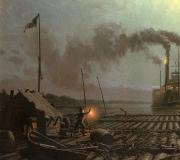Topic: “Land of the Rising Sun. Cherry blossom festival"
Completed by students of grade 8 “A”: Yulia Manannikova, Galina Dolgopolova, Alexander Manukovsky, Anastasia Kutyakova, Roman Naimushin
Checked by teacher: Tatyana Nikolaevna LOMAKO
Slide 2
The Land of the Rising Sun is an island. Japan is located in East Asia. Located in the Pacific Ocean, washed by the Sea of Okhotsk, Japan and East China. The total area of the country is 372.8 thousand km2, of which 13.5 thousand km2 is water space.
Slide 3
The discovery of Japan began in 1853, with the approach of the Russian squadron of Admiral Putyatin to the islands, followed by the British and American squadrons. In March 1854, under pressure from the powers, Japan signed a number of unequal treaties with strong powers.
Slide 4
After the overthrow of the Tokugawa regime, power in 1867 was concentrated in the hands of Emperor Mutsuhito, who carried out the “Meiji reforms” (enlightened rule) in the country, as a result of which, over two decades, Japan not only caught up with the developed powers, but in some indicators even surpassed them, starting colonial policy. One of the authors of Meiji was Prime Minister Ito Hirobumi, as well as the emperor himself.
Prime Minister Ito Hirobumi
Slide 5
- Emperor Mutsuhito
- Coat of arms of Japan
- Flag of the Japanese Empire
Slide 6
in the 80s A widespread movement for a constitution unfolded in the country. A special mission was sent to Europe and the USA to familiarize themselves with and choose the most suitable version of the constitution. The mission chose the Prussian version of Bismarck.
In 1889, Mitsuhito proclaimed a constitution, thereby limiting his power.
Slide 7
The reforms opened up wide scope for private entrepreneurial activity for the merchants.
Financial reform introduced a single currency, the yen. Industrial enterprises are built and factory chimneys become part of the Japanese landscape. By order of the emperor, factories were built at the expense of the treasury, which were then sold or leased on preferential terms to trading and industrial firms close to the imperial circle.
Soon the iron ones cut through the country in all directions.
In the 90s, as in European countries and the USA, industrial growth began in Japan.
The shogunate was replaced by a new state, which consciously adopted from the West everything that could make Japan an industrialized country.
Slide 8
The Meiji results were incredible.
- Steamboats on Japanese rivers.
- Giants of the new Japanese industry.
- At the weaving factory
Slide 9
Japan's foreign expansion began in 1894. In 1894-95, Japan defeated China and captured Taiwan and Korea. And in 1904-1905 it defeated Russia in the Russo-Japanese War.
Sino-Japanese War.
Slide 10
The flight of the Chinese army during the Sino-Japanese War.
Slide 11
Russo-Japanese War 1904 -1905
- Date: January 27, 1904 - August 23, 1905,
- Place: Manchuria, Yellow Sea, Sea of Japan, Sakhalin...
- Reason: clash of zones of influence of the Japanese and Russian empires in Korea and Manchuria.
- Result: victory of the Japanese Empire
Slide 12
Slide 13
Slide 14
Japanese culture...
Japanese culture is a unique, original phenomenon not only in the context of global culture, but also among other eastern cultures. It has continuously developed since the 10th - 11th centuries. From the 17th to the mid-19th centuries, Japan was practically closed to foreigners (connections were maintained only with the Netherlands and China). During this period of isolation in Japan, national identity was creatively developed. And when, after several centuries, the rich traditional culture of Japan was finally revealed to the world, it had a strong influence on the subsequent development of European painting, theater and literature.
Slide 15
Literature
For a long time, Japanese literature was influenced by China, literary works were also created in Chinese. The first written monuments are considered to be the collection of Japanese myths and legends “Kojiki” and the historical chronicle “Nihon Shoki”
Slide 16
Painting
Japanese painting (絵画 “painting, drawing”) is one of the most ancient and sophisticated of Japanese arts, characterized by a wide variety of genres and styles.
Japanese painting, as well as literature, is characterized by assigning a leading place to nature and depicting it as the bearer of the divine principle.
Slide 17
Calligraphy
In Japan, calligraphy is considered one of the arts and is called shodo (書道 “way of writing”) Along with drawing, calligraphy is taught in schools.
The art of calligraphy was brought to Japan along with Chinese writing. In ancient times in Japan, mastery of the art of calligraphy was considered a sign of a cultured person. There are several different styles of writing hieroglyphs. Buddhist monks were involved in improving the styles of writing hieroglyphs.
Slide 18
Sculpture
The oldest art form in Japan is sculpture. Since the Jomon era, a variety of ceramic products (ware) have been made, and clay dogu idol figurines are also known. Wood was used as the main material for sculptures (as in Japanese architecture).
Slide 19
Architecture
Japanese architecture has as long a history as any other component of Japanese culture. Initially heavily influenced by Chinese architecture, Japanese architecture has developed many differences and approaches unique to Japan. Examples of traditional Japanese architecture include temples, Shinto shrines, and castles in Kyoto and Nara. In general, Japanese architecture is characterized by a desire for simplicity.
Slide 20
Theater
One of the earliest types of theater was theater (能 “talent, skill”), which developed in the 14th-15th centuries; actors played in masks and luxurious costumes. Theater is considered "masked" drama. In the 17th century, one of the most famous types of Japanese traditional theater emerged - kabuki (歌舞伎 “song, dance, skill”), the actors of this theater were exclusively male, their faces were made up in a complex way. The art of onnagata (女形 female character), actors who play female roles, is highly valued.
Japan today
Today Japan is one of the largest financial centers in the world and one of the most highly developed countries in the world. It ranks second in terms of spending on research and development, first place in terms of know-how presented to the market. The largest exporter of high-tech equipment and mechanical engineering.
Slide 24
The young state quickly and clearly carried out a number of reforms that destroyed the foundations of traditional society. This allowed Japan to follow the path of modernization and development of a capitalist economy. This was facilitated by the traditional Japanese propensity for useful borrowings and lack of contempt for foreign culture.
The development of imperialism took place in conditions of a narrow domestic market and poverty for the overwhelming majority of the population. At the same time, nationalist sentiments developed in the country, and ideas about the “chosenness” of the Japanese people were implanted. Together with the old military traditions of the samurai, this made Japan an aggressive country seeking to seize foreign lands.
Slide 25
Slide 26
View all slides
https://accounts.google.com
Slide captions:
“TRAVEL THROUGH JAPAN” Teacher of MDOBU kindergarten No. 3 “Cheburashka” Lugovskaya N.A. Part one Geographical location Coat of arms and flag Capital Clothing National cuisine
Japan is an island state, located in the Pacific Ocean, washed by the East China, Okhotsk, and Japan seas.
The national flag of Japan features the sun - a large red circle on a white background. White color is a symbol of purity. This reminds us of the name of Japan - the land of the rising sun. The coat of arms is a yellow chrysanthemum consisting of 16 double petals, which symbolizes the sun. The coat of arms has a magical meaning. COAT OF ARMS AND FLAG OF JAPAN
TOKYO - THE CAPITAL OF JAPAN
O. Shikoku is the smallest of the 4 islands. O.Kyushu is the southernmost of the 4 Japanese Sacred Tori Gates
O. Honshu is the largest and most important of all the islands of Japan. Mount Fuji is the majestic symbol of Japan.
Sakura is the symbol of Japan
Pagoda Temple Buddhist Temple Gosse Imperial Palace Kyoto
Traditional Japanese houses have very little furniture. The entire floor is covered with rice straw mats. They sit on the floor when they have lunch, and sleep on the floor, with special mattresses laid out. JAPANESE HOUSES
National Japanese cuisine
Preview:
To use presentation previews, create a Google account and log in to it: https://accounts.google.com
Slide captions:
“TRAVEL THROUGH JAPAN” Teacher of MDOBU kindergarten No. 3 “Cheburashka” Lugovskaya N.A. Part two Culture Toys and games Sports Holidays
Japanese games for children OHAJIKI This game is usually considered a game for girls. Players take turns snapping their fingers at small coin-shaped figures called ohajiki, trying to hit other figures. Previously, pebbles were used in the game. Now the figures are usually made of glass. When playing, you need to form a circle with your thumb and index (or middle) finger, and then click on the figure with your thumb. KENDAMA (translated as KEN - sword, DAMA - ball). Many played this game, trying to catch a tied ball in a bag or glass. OTEDAMA is a Japanese juggling ball. DZYAN-KEN - “Rock, paper, scissors”
Bonsai is the Japanese art of growing dwarf trees for decorative purposes, as well as the tree itself.
ABOUT RIGAMI the most favorite figure is the crane; among the Japanese it is considered a sacred bird.
Popular in Japan: martial arts (judo, kendo and karate, sumo, aikido); kyudo (“way of the bow”) - archery SPORT
Kadomatsu New Year
And hieroglyphs Happiness Joy
Thank you for your attention! どうも “TRAVEL THROUGH JAPAN”
Japan is a country of high culture and literacy, where great attention is paid to the education and upbringing of children from early childhood. The Land of the Rising Sun owes its well-being, first of all, to strict adherence to ancient traditions, which include the veneration of elders, kimonos, features of Japanese cuisine, table setting, tea ceremony, and ikebana. Japanese traditions can be observed in literally every aspect of the country's life. The Japanese treat nature with care and love, admiring the natural beauty of the landscape, flowers or sea.

Earthquakes often occur in Japan, so lightweight houses have long been built here, the destruction of which does not kill people. The houses are made of wooden slats. The walls slide open like bookcase doors. This allows you to easily and quickly change the layout of your home. Instead of chairs, the Japanese place soft cushions on the floor. There is usually little furniture.

Numerous national dishes are prepared from seafood. One of the most famous dishes in the world is the Japanese dish "sushi", small rolls of dried seaweed stuffed with rice and toppings. In Japan, they still remain faithful to wooden chopsticks. They are used only once and then thrown away.

Tea drinking in Japan is a whole ritual called “ta no yu”, which means “tea ceremony”. No more than five people participate in the ceremony. At the end of the tea ceremony, the hosts give the guests a paper bird – a crane – as a farewell gift. It is believed that it brings happiness to people.

The Japanese customarily bow and smile. Even when the mother, according to Japanese custom, carries the baby on her back, she makes him bow with each bow, thereby giving the first lessons in honoring elders. Weddings in Japan are usually held in the summer. Most rituals are carried out in the Shinto style.

Particular attention is paid to hairstyles. The hairstyle was covered with melted butter or wax to make the hair shiny and healthy looking. To preserve the tiered hairstyle, the head was placed at night on special benches with a recess for the neck. Thanks to this, the hairstyle remained in place for a long time, the woman was beautiful for 2 weeks.




Compiled by:
N. Ya. Loginova, primary school teacher, MAOU “Secondary School No. 28”, Syktyvkar



General information
- The official name of the country: Nippon (Empire of Japan)
- Capital: Tokyo (11.7 million people)
- Religions: Shintoism, Buddhism
- Official language: Japanese
- National currency: yen
- Largest cities: Yokohama, Osaka, Kobe, Nagoya, Sapporo, Kyoto

Fujiyama
Holy Mountain in Japan traditions. The volcanic slopes of one of the most beautiful mountains in the world are capped with snow.

Sakura is a symbol of Japan
Spring in Japan is cherry blossom season. It begins not when flowers appear on individual trees, but when the whole country turns into a magical garden of white and pink flowers.

Peace Memorial Park Hiroshima
In August 1945, as a result of the American atomic bombing Hiroshima and Nagasaki turned into a nuclear desert.
Only Nagasaki became victims of the atomic bomb 80,000 people

Japan in numbers
- Square: 377,835 km 2
- Population: 127 million Human
- Population density: 336 people per km 2
- Coast: 29751 km
- Highest peak:
Fuji (3776m)

Climate and relief
- Japan is a mountainous country with vast forests and more than 200 volcanoes. The Japanese islands are located in a seismically troubled area. About 1,500 earthquakes occur in the country every year.
- The climate is very varied, temperate, humid and rainy. Average temperature in Tokyo in January: +5 O C, in July +26 O WITH.

Architecture
The Japanese have developed rational design techniques for both residential and temple architecture. At the same time, the unique expressiveness of each building was preserved, complemented by the beauty of the surrounding nature.
Medieval Japanese art grew under the strong influence of Korean and especially Chinese cultures.

Kyoto
Temple in Kyoto. Kyoto is a city that was the capital of the country and the residence of the emperor, the “Son of Heaven,” for more than 1,000 years.

Horyuji Monastery.
Hakurojo Castle
in Himeji. 1601-1609

Sumo – traditional national sport in Japan. This is one of the types of wrestling in the ring, carried out according to strict rules.
Wrestlers' weight not less than 170 kg.

Geisha are young women who are trained in special schools. They know how to entertain guests with intelligent conversation, dancing and singing.
Kabuki is a traditional national theater where all roles are performed by men.

Shinto - ancient religion
Everything that exists on Earth is animated. Every stone, every breath of wind has a special spiritual power.
Living in harmony with the world around you



Our life is a dewdrop,
Let just a drop of dew



